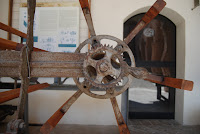(First off: I'm sorry for my lack of posting. The program in Italy is now over, but I will still be posting about it. We had class basically from 8:30 in the morning until 7:00 at night, with rather limited internet access in between. So forgive me and stick with me :))
Paper. That's what we're all here for. Old paper. Really really old paper.
As I introduced in my first post, our teacher's name was Konstantinos Choulis. Konstantinos is
 currently an assistant professor of book and paper conservation at the Technological Educational Institute in Athens. Previously, he worked in the Vatican Library and taught conservation in Italy.
currently an assistant professor of book and paper conservation at the Technological Educational Institute in Athens. Previously, he worked in the Vatican Library and taught conservation in Italy.
The assistant for the course in Giovanni. He was one of Konstantinos's student's and now works in a conservation lab in Rome.
The course is broken up into two parts - morning lecture and afternoon workshop. In the morning, we have a lecture on restoration theory with both programs (paintings and paper) and then split. In our program's lecture, we discuss various aspects of book and paper conservation. Book and paper conservation could really be separated into two fields, as book conservation involves the binding and other elements. In the class, we won't actually be conserving a book - at least not individually. Collectively, we are conserving a Greek liturgical book, but I'll get to that later. Some of the things we have discuss include:
- a brief history of paper making
- the differences between oriental and western paper making
- sewing systems for books
- the different structures of books
- sewing systems for books
- the different structures of books
- types of damage
- and lot, lots more.
The first document we worked on was a Greek text called ΜΗΝΟΛΟΓΙΟΝ (Menologion).
The book is the one pictured in the banner of my blog. The book is from the 18th-19th century. It was missing the covers, so the front and back pages were unprotected and therefore pretty damaged, as shown below.

A basic explanation of the structure of a book: every book is made up of signatures, or quires. Each quire is made up of folios. Folios are large sheets of paper, the same height of the book and twice the width. When the folio is folded in half, it produces a bifolium. Each bifolium has 4 sides. Each signature typically has between 3-5 bifoliums, depending on the thinckness of the paper, as well as the type of sewing to some extent. So: If you have a book that has 15 quires and each quire is made up of 4 bifoliums:
15 quires
x 4 bifoliums
60 bifoliums
60 bifoliums
x 4 pages (each bifolium)
240 pages total
Make sense?
Each person in the class got their own bifolium from the book to work on. This was mine:

The above picture shows the various steps of the process. The top left picture (labeled A) is the before picture - the condition of the paper when I started working with it. Photos B and C are during pictures at various stages during the process. Photo D is the after picture - I know it's a little bit hard to see, but you'll notice how flat it is compared to the other pictures. The crescent shaped tear in the lower left corner of the page has been repaired. In photo D, if you look closely you can see that Japanese paper has been added to all the edges to make the edges nice and straight and make the bifolium a rectangle again.
I'll dedicate an entire post on the specifics of what was done, so be looking for that soon!

The completed before-and-after picture.
The cool thing about us all getting our own individual bifoliums to work with was that we each had different damages to deal with. There are three categories of damage - chemical, biological, and mechanical. A book or paper usually doesn't have only one type of damage - there are usually at least two of the three categories of damage evident on the page. So we not only learned through dealing with the damage on our own page, we also learned through watching the other students in the class dealing with their own damage.
Coming up soon:

Fabriano paper mill

The Conservation Process

The San Gemini Documents
...and more!
Ciao, a presto!
